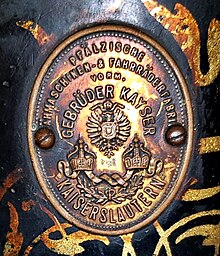Palatinate sewing machine and bicycle factory formerly the Kayser brothers
| Palatinate sewing machine and bicycle factory formerly Gebrüder Kayser AG | |
|---|---|
| legal form | Corporation |
| founding | 1864 |
| resolution | 1931 |
| Reason for dissolution | Merger with Gritzner |
| Seat | Kaiserslautern , Germany |
| Branch | Sewing machine manufacturer , bicycle manufacturer , automobile manufacturer |

Palatinate sewing machine and bicycle factory formerly Gebrüder Kayser AG was a German manufacturer of automobiles and other technical devices.
Company history
The company from Kaiserslautern was founded in 1864 and converted into a stock corporation in 1891 .
In 1899 the production of automobiles began. The brand name was initially Kayser , from 1902 Primus . The company exhibited at an automobile exhibition in Frankfurt am Main in 1901 and at the German automobile exhibition in Berlin in March 1903 . In 1903 the production of motor vehicles ended .
In 1931 there was a merger with Gritzner to form Gritzner-Kayser AG .
vehicles
Brand name Kayser
The only four-wheel model under this brand name was the Primus model . This was a small car. The drive was provided by a single-cylinder engine with 5 hp , which was mounted in the front of the vehicle. The vehicle had thermosiphon cooling , electrical ignition, a three-speed transmission and chain drive. The open body offered space for two people.
Motor tricycles were also created. In 1899 one was at the first major international motor vehicle exhibition in Germany. With the front single wheel, handlebars, saddle and the motor between the rear wheels, it was very similar to the De Dion Bouton motor tricycle . An air-cooled single-cylinder four-stroke engine powered the rear wheels. A trailer for transporting goods was also available.
Brand name Primus
The previous model was offered from 1902 under the brand Primus and the model name Doktorwagen . There were no differences in terms of motorization. This was followed by a model with a two-cylinder engine and one with a four-cylinder engine .
literature
- Harald H. Linz, Halwart Schrader : The International Automobile Encyclopedia . United Soft Media Verlag, Munich 2008, ISBN 978-3-8032-9876-8 .
- Nick Georgano : The Beaulieu Encyclopedia of the Automobile, Volume 3 P – Z. Fitzroy Dearborn Publishers, Chicago 2001, ISBN 1-57958-293-1 (English)
Web links
Individual evidence
- ↑ a b Share of the successor company including a short company description (accessed on November 10, 2019)
- ^ Peter Kirchberg: Automobile exhibitions and vehicle tests around the world. The best from "Der Motorwagen", the magazine for the automotive industry and engine construction. Part 1: 1898-1914. Transpress, Berlin 1985, p. 98.
- ↑ Michael Wolff Metternich : 100 years on 3 wheels. German three-lane vehicles through the ages. Neue Kunst Verlag, Munich, ISBN 3-929956-00-4 , p. 196.
